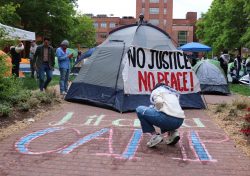Over this past summer and beginning of the school year, students have reported multiple cases of mold in Kennedy Hall, Village C, LXR Hall, Henle Village, Village A, and Alumni Square. The mold has both had a detrimental effect on student health and stirred discontent about the responsiveness of Georgetown housing and facilities.
According to the Environmental Protection Agency, residents of buildings with mold growth may experience health problems such as “headaches, breathing difficulties, skin irritation, allergic reactions, and aggravation of asthma symptoms.” Although different types of mold vary in their health threats, exposure to mold for extensive periods can cause even more severe diseases like cancer and mental illness.
During the summer and start of this semester, multiple apartments in Henle Village saw extensive mold problems, which required residents to be temporarily evacuated.
“Over the summer, we had about five to six different apartments [with mold] in Henle, and then as the folks moved in, we had about another five or six,” said Robin Morey, vice president of planning and facilities management. According to Morey, the primary causes were leaking air conditioning units and windows left open during periods of rain.
In general, mold on campus occurs in isolated incidents. Facilities is responsible for ensuring that dorms are safe through procedures including mold remediation.
“Reports of mold are usually inspected within the same day by either facilities management or health and safety personnel. If the report is validated, then cleaning/remediation is initiated—usually within a day or two,” Morey wrote to the Voice. “The reports [we receive] can vary significantly with most being in the summer. Beginning move-in weekend to present, we received approximately 21 reported instances of mold—all of which have been cleaned.”
Students, however, have had mixed experiences with facilities’ response speed and efficacy to reported mold problems.
“My mom and I went to facilities, to housing…I said, ‘Isn’t this a priority? It deals with student health.’ And they said ‘No, we only have so many people,’” said Liz Sellers (MSB ’14), who lives in Henle 37, one of the apartments that was evacuated. “My mom and I were going all around campus, trying to find somebody to take care of it, and we actually bumped into President DeGioia after convocation. We were talking to him about it, and then he contacted the facilities and housing people. Really, we had to go all the way to President DeGioia in order for them to handle mold, when it shouldn’t have been there in the first place.”
Students also said that if facilities responded to their calls, their response methods were often ineffective.
“We put in at least two or three facilities complaints about the mold. For the black mold in the shower, they came and bleached it, but failed to bleach under the plastic handle, so it was obviously still there. At the beginning of the year, we reported black mold on the ceiling of our living room, and they never came to clean it up,” wrote Julia Christensen (COL ’15), who lived in Henle last year. “A little over a month after we moved out, Henle 33 was evacuated for excessive mold.”
Erica Lin (COL ’14), who lives in a University townhouse on Magis Row, has faced similar complications when dealing with facilities.
“We put in this huge work order [about black mold at the beginning of the semester], but there have been issues getting work orders to go through,” Lin said. “I think what they did was they painted over it last time and it just grows back.”
The EPA strongly recommends to never paint over mold because it is ineffective and leads to more serious problems. Morey denied that facilities utilized this approach. “This is not an acceptable procedure to deal with mold and facilities management does not do so,” he wrote.
In addition, facilities largely depends on students to report problems with mold in their residences.
“To be clear, any report of mold in any Georgetown unit will be addressed by facilities… but these incidents need to be reported to facilities in order for facilities to fix them,” wrote Rachel Pugh, director of media relations.
For anyone who has no professional training in mold remediation, spores may not be easily identifiable. In addition, according to the EPA, “it is possible that mold may be growing on hidden surfaces, such as the back side of drywall, wallpaper, or paneling, the top of ceiling tiles, [and] the underside of carpets and pads.”
“Our room flooded once in VCW, and then I started coughing a lot. And then two months later, our room flooded again and they moved the dresser by my bed and there was mold underneath it,” wrote Tessa Pulaski (SFS ’15). “I was on an inhaler … [and] I didn’t [ever suspect it was mold].”
The University did not comment on how many students have become ill due to mold. However, the symptoms of mold are easily confused with those associated with the common cold or allergies. Compounding the problem that mold can grow visibly undetected, students may experience extended symptoms of illness without realizing the cause.
When asked if it was feasible for facilities to regularly check rooms during the year, Morey responded affirmatively, writing that “we are redesigning our inspection program and we envision regular inspections.”
Grace Brennan contributed to this report.




